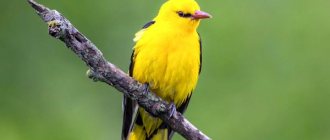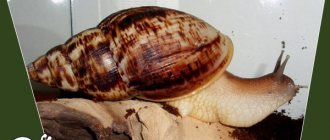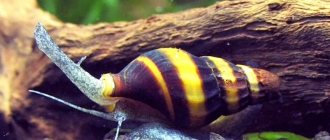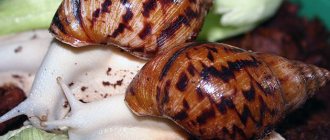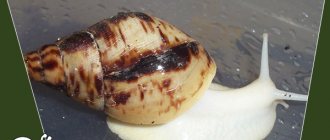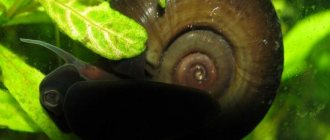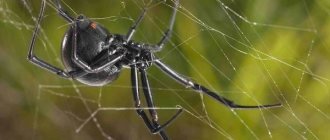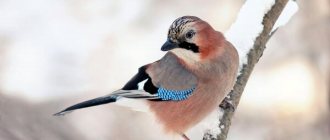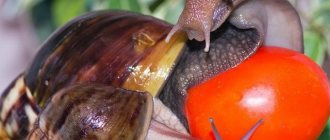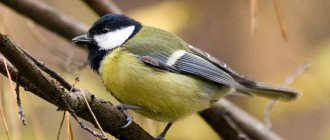The most popular types and varieties of snails
There are a huge number of mollusks in the world. They crawl on the ground, in fresh water bodies and oceans, causing benefit and harm to humans.
Land breeds
Land snails are cute and unpretentious pets, caring for which does not require much effort or financial expenditure. The most popular among them are Achatina. Let's consider the main ones:
- Achatina reticulata is distinguished by its mobility and curiosity. Always pays attention to what is happening around him. The neck and head are colored brown or black, the edges of the legs are several tones lighter. Brown dots and stripes are scattered in a chaotic manner across the entire surface of the shell. The mollusk is unpretentious in food. He can be trained to feed by the hour. Can lay up to 300 eggs.
- Achatina fulica is a very lazy mollusk that prefers to be at rest most of its time. The shell is colored black, red or brown. The shell is large and can grow up to 20 cm. If you feed the pet well and do not disturb it often, the female actively reproduces, laying a large number of eggs. Life expectancy in captivity is up to six years.
- Achatina iradeli is inferior in size to its previous relatives. Its shell does not grow more than 5-7 cm. The color of the mollusk is yellow. Why is it called “lemon”. A distinctive feature of the Iradel is that it does not lay eggs, but gives birth to live young. Their number can reach two dozen.
- Achatina vulgaris has a tiger color. It is very large, and its shell can grow up to 30 cm. It is inactive in behavior and prefers to rest in its free time from eating. Life expectancy in captivity is up to 7 years.
Achatina reticulata
Sea snails
- Cirpea is a sea snail that is difficult to live without in a marine reef aquarium. It feeds on algae and cleans the aquarium well of their deposits without disturbing the corals. The size of a mollusk in captivity rarely exceeds 5 cm. While in nature there are specimens measuring 15 cm. Cirpea is active at night and in the evening; during the day it rests somewhere in a gorge of stones.
- The geographic cone is the most poisonous mollusk in the world. He lives in the ocean. An adult is capable of releasing a cloud containing a high insulin content into the water. The latter leads to a sharp decrease in the victim’s blood sugar level and the person dies. Today, an antidote for the mollusk has not yet been found.
- The giant Australian whelk is the world's largest snail, the shell of which can reach 90 cm in length. The mollusk's usual habitat is the coastal part of northern Australia. He descends to a depth of 30 m and feels comfortable there. Eats worms and other small inhabitants of the aquatic world.
Giant Australian trumpeter
What types of gill snails are there?
- Bithinia are small snails with a conical, ovoid or tower-shaped shell. Their shell does not grow more than 2 cm. The snail's shell is colored brown, dark gray or beige. The mollusk is found in fresh water.
- The meadow or viviparine, as it is popularly called, is an inhabitant of fresh water bodies. Its shell has the shape of a blunt cone and reaches a size of up to 4 cm. Depending on the habitat, the color palette of the mollusk can vary from red-brown to beige with a green tint. These are viviparous individuals living in Europe.
- Buccinums (pumpeters) are marine mollusks with a shell length of 25 cm. The shape of the shell is elongated, the color is light brown. This is a predator that paralyzes its prey with poisonous saliva. Its usual habitat is cool ocean waters in the Northern Hemisphere.
Luzhanka
Pulmonary
- A prominent representative of pulmonary mollusks is the grape snail . It is customary to breed it on an industrial scale due to the value of the resulting meat. It is called “natural Viagra,” and pharmacists claim that such food can activate the vital processes of the human body. The mollusk is colored beige, less often dark gray. The diameter of the shell is 5-6 cm. It feeds on vegetation, for example, grape leaves, cabbage or lettuce.
- The snail coil is colored light beige and sometimes orange-brown. The size of its shell can reach up to 3.5 cm. The habitat of the reels is shallow water bodies filled with a large amount of vegetation.
- The red roadside slug does not have a shell. Its body is colored red-brown, orange and even brown. This is a land mollusk that lives in gardens and vegetable gardens. Its body reaches 10 cm in length and is covered with mucus.
Snail coil
Aquarium
Shellfish play an important role in the aquarium. They purify water, soil and eat up leftover fish food. The most popular among this variety of mollusks are:
Types of land snails
The largest and most diverse domestic snails, the Achatina, are best suited as pets.
Achatina reticulata is a very curious and active species of domestic snail.
She is very interested in her surroundings and in order to be aware of everything that is happening, she often raises her head. The color of the head and neck is brown or black, the edge of the leg is light. The shell is “painted” with dots or stripes. Unlike its relatives, reticulata grows very quickly. The diameter of the shell reaches 20 cm. They are unpretentious in care and eat everything. They are easy to train to eat by the hour. In captivity they can lay up to 300 eggs. Achatina fulica is the laziest representative of the Achatina family, spending most of its time in a state of rest. This is a very large snail , the color of the shell can be black, red, brown, its size reaches 20 cm. At home it lives up to 6 years, actively reproducing.
Achatina immaculata. The coloring is very varied. It is distinguished from other representatives of the Achatina genus by a pinkish or light purple rim along the shell and a characteristic pink stripe on the head and neck. There are 15-200 eggs in a clutch.
Interesting: The character of the fox and its maintenance at home
Achatina albopicta. It has some similarities with the reticulata, but is smaller in size (up to 16 cm). The tip of the shell is pink, the rim of the shell is white or yellowish. Unpretentious, but a little gluttonous. It can produce offspring of up to 300 small individuals.
Achatina was destroyed.
Due to its characteristic yellowish color, it is also called “lemon”. This is a very small snail, only 5-7 cm in size. It is unpretentious in keeping, like its relatives, but it has a very interesting difference : it is the only Achatina that produces not eggs, but live young (20-25 individuals).
Achatina brown. It is similar to fulica, differs only in the shape of the shell: fulica has a cone-shaped shell, without curves, and the shell of brown Achatina is semicircular. She is sociable by nature and unpretentious in her content. Like other snails of the Achatina genus, it is very prolific.
Achatina vulgaris. Huge size snail, tiger-colored. In nature, its shell reaches a length of 30 cm. The domestic Achatina vulgaris has a more modest size (up to 22 cm). The color is orange or light yellow, the stripes on the shell are black or brown. Legs dark in color. They live at home for up to 7 years. The character is calm; in his free time from eating, he prefers to relax in his hole.
Another type of domestic snail that is popular among breeders is grape snails. They differ from Achatina in being much smaller in size (5 cm long, 4.5 cm wide), and their colors are very diverse.
Land
These are some of the popular types of pets. There are several types of mollusks representing this subgroup. Most land snails belong to the Achatina species. The second most common representative is the grape snail.
Achatina
The size of these gastropods sometimes reaches 25 centimeters. Body color varies from light brown to green. When maintaining, a container with a volume of 25–30 liters is required with the obligatory presence of soil. It must be kept moist at all times. They feed on plants, fruits and vegetables. Banana slices serve as a delicacy. The diet must contain protein foods. Daphnia and gammarus are used as feed.
There are a huge number of varieties of Achatina. Of the most interesting and unusual individuals, the following can be distinguished.
- Achatina fulica is a lazy mollusk. In his free time from eating, he prefers to relax in the house. Its size reaches 20 centimeters. Females are fertile and lay large numbers of eggs. The shell has a conical shape. The colors come in a variety of colors. In the wild, there are individuals of brown, cream and dark color. She leads a terrestrial lifestyle. This type of land snail is capable of laying up to 400 eggs during the breeding season.
- Achatina iradeli is an unusual species of snail, as it has the ability to give birth to viviparity. During the mating process, parents change sex. About 20 snails are born at a time. The color of the shell of the mollusk is yellowish. It uses berries and fruits as food, as well as rotten cabbage leaves. It has pulmonary breathing, which allows the snail to live on land.
Grape
This is a large land mollusk that lives in forests, meadows and parks. The width of the grape snail's shell reaches 45 millimeters. Its color is usually yellowish. Life expectancy ranges from 5 to 7 years. It feeds on plants and vegetables. The diet contains burdock, cabbage, and dandelion leaves. It loves moisture and hides under stones and other shelters during dry periods. Before the onset of cold weather, he leads an active lifestyle. When the temperature drops, it enters a state of suspended animation.
Keeping land snails
It is necessary to purchase a special terrarium, the roof of which should have small ventilation holes so that the snail cannot get out of its home on its own. A layer of specially treated earth or coconut substrate is placed at the bottom, used as soil. The thickness of the layer depends on the size of the gastropod, so that during daytime sleep the snail can completely bury itself in the ground. It is necessary to constantly maintain soil moisture by spraying it with water once a day.
Under no circumstances should the flooring be over-wetted! Interesting: What types of spiders are there in nature?
The volume of the terrarium must be at least 10 liters per individual. The temperature inside must be maintained at 25-27 degrees (depending on the type of snail). For heating, it is better to use external heat sources (thermal cords or thermal mats), since heaters located inside the terrarium can cause severe burns to its inhabitants. You can also use incandescent lamps as a heat source, after protecting your pets from the light. Under no circumstances place the terrarium on a windowsill : the bright sun can interfere with the snail’s daytime rest and will also greatly heat up its home. Another danger is drafts. Snails can freeze, because the temperature is below +18-20 degrees - it’s already cold for them.
You can green up your snail aquarium by adding non-toxic plants, such as lettuce or cat grass. For decoration, use sphagnum moss (sold in a flower shop), coconut shells, various driftwood from a pet store or from the forest (necessarily well processed).
The food bowl should be made of soft material (you can use plastic lids for jars). There should be no glass, metal, or ceramics in the terrarium! Snails do not need light, so you can turn it on only if you want to watch your pets.
Once a day, the walls of the terrarium must be wiped with a damp cloth, without using chemicals, as they can cause severe burns. It is allowed to use ordinary soda, which must then be thoroughly rinsed off. General cleaning should be done every week. There should be a separate sponge for washing the terrarium and the dishes in it.
Land snails love to take a bath. To do this, you can place them in a shallow bowl of water or put them under a stream of warm water (not hot!). While bathing, thoroughly clean the sink from adhering dirt with a soft brush.
Water
Gill snails prefer to live in salt water. There are individuals that live in fresh water bodies. Snails with different shell colors have been bred under artificial conditions.
Helena
Inhabits the flowing waters of Southeast Asia. Loves rivers with muddy banks. Adapted well to life in aquarium conditions. The diameter of the shell does not exceed 20 millimeters. This snail can live for about two years. A distinctive feature is that it uses its fellow creatures as food. It also feeds on settled particles of fish food. Aquarists keep it to reduce the snail population in their tank. Helena prefers slightly salted water with medium hardness.
Ampoules
They are small representatives of the gastropod order. Ampullaria live in fresh water bodies of Europe. It has a special cavity divided into two parts. With its help, the snail breathes both underwater and on land. At home, individuals with a yellow shell color are popular. Its diameter sometimes reaches 7 centimeters. By nature it is omnivorous. In aquariums it feeds on algae particles and food debris that has settled to the bottom. The optimal water temperature is 20–25 degrees. Acidity and hardness must be maintained at a neutral level. Lack of microelements leads to the destruction of the shell. They lead an active lifestyle. They tend to reproduce frequently. Life expectancy in captivity is 1–2 years.
River viviparus: content, photo, description
Many novice aquarists know almost nothing about aquarium snails. This is not very good! There are also types of predatory snails that do not tolerate other types of snails on their territory! To help you learn a little about snails, we decided to write for you about some of the gastropod species that live in the aquarium environment.
Viviparus , also known as the river viviparus , is a charming gastropod. The size reaches an average of 5-6 cm. Its main habitat is the standing reservoirs of vast Europe.
The river viviparus has a charming shell, cone-shaped, with up to 7 turns that are smoothly wrapped. The color of the mollusk shell is brown or brownish-green, with dark stripes along its entire length. The bottom of the shell is equipped with a special lid that protects the livebearer from various dangers. The mollusk breathes exclusively through gills. The snail prefers soil, both at the bottom of the aquarium and on dry land. A big fan of various driftwood and pebbles.
Content
Maintenance and feeding
Probably the most unpretentious snail to keep. Any volume is suitable, even a 3-liter jar, the main thing is that there is enough food for the snail. There are also no special requirements for water, because in nature the water in ponds is far from clean, but as a rule, snails are kept in common aquariums and the conditions created there will be ideal for Livebearers.
Like all snails, the Viviparus is an aquarium orderly, eating leftover food, detritus, dead fish, and does not touch aquarium plants. Like all aquarium inhabitants, snails need to be monitored; if you see that a snail has been lying in one place for several days, then it needs to be taken out and examined; dead Livebearers, like other snails, heavily pollute the water, such snails need to be removed from the aquarium.
Since the mollusk spends most of its time at the bottom, it can be fed with catfish food. As aquarists say, for a 50-liter aquarium, 10 livebearers are enough.
The quality of water in the aquarium is not important for these beauties. In nature, they live in fairly marshy areas, which is why they are not picky about water. But, after these words, this does not mean that you need to clutter your aquarium and not change the water in it at all.
They have their specific purpose as “scavengers” - aquarium mollusks do this just fine! Thanks to these “vacuum cleaners,” very little debris remains at the bottom of the aquarium. It’s just that if there is a lot of garbage, when it rots, it can cause the most acute forms of poisoning in all residents of the aquarium, or it can become the number one distributor for many types of harmful bacteria. The river livebearer does not need special, separate food; it eats everything that is at hand.
The livebearer reproduces very often. Up to 30-40 mollusks are produced for the “white light” at a time. Babies, already at birth, have a transparent but very fragile shell-shell. But, over a certain period of time, these transparent shells become a natural brown color, like those of adult snails.
The number of snails that should be in the aquarium is at your discretion! When breeding mollusks, they must be planted in a separate place.
Behavior in the aquarium. Peaceful aquarium inhabitants, they can live together with other species of snails such as Melania, Physa, etc.
Habitat
The homeland of the river viviparus is Europe. The mollusk lives in ponds, lakes, and any bodies of water with standing water and dense vegetation. The livebearer prefers to stay on plants or in silty areas of the reservoir. Appearance and color.
The shell of the Livebearer is round with a cone-shaped top, about 5 cm long and has 6-7 curls of brown-green color with black stripes. The Livebearer, like the Ampularia, has a lid that it closes in case of danger. The mollusk breathes using gills. Other species can also be found in nature
Livebearer: Amur, Bolotnaya, Ussuriysk, Minted. All these species differ mainly in the structure and color of the shell. Sexual characteristics. Livebearers are dioecious. Males differ from females in their head tentacles: in females these tentacles are of the same thickness, in males the right one is greatly expanded and plays the role of a copulatory organ (Zhadin, 1952).
SNAILS-CONTENT FEEDING DESCRIPTION REPRODUCTION COMPATIBILITY
AMPULAR CONTENTS REPRODUCTION COMPATIBILITY PHOTO DESCRIPTION.
AQUARIUM SNAIL COIL CONTENTS REPRODUCTION COMPATIBILITY DESCRIPTION PHOTO.
PHYSAL SNAIL CONTENTS COMPATIBILITY REPRODUCTION DESCRIPTION PHOTO VIDEO.
NERATINA SNAIL CONTENTS REPRODUCTION DESCRIPTION PHOTO COMPATIBILITY.
Other types
Melania
He is a tank cleaner type, like all representatives of this breed. They eat the remains of rotten food at the bottom of the aquarium. The size does not exceed three centimeters. It has a gray-green shell color with dark stripes. They cannot tolerate low water temperatures in tanks, since in the wild their habitat is the tropics. They multiply quickly, which causes inconvenience, as they are difficult to breed. They spend most of their lives buried in the ground. The hard shell serves as a defense mechanism against predatory fish. They feed on settled fish food. If desired, you can include pieces of vegetables in your food.
Has a small body size. It is useful for the aquarium because it cleans the walls of the tank from white deposits. The unusual shape of the shell allows it to penetrate into corners of the aquarium that are inaccessible to other inhabitants, and the presence of pulmonary respiration allows it to live in different habitats. The water temperature when kept is 22–24 degrees. Feeds on aquarium algae. The state of the gastropod's shell determines the level of acidity in the tank. Its elevated level leads to the destruction of the mollusk's protective word.
Neritina
A typical representative of the gastropod order. It has a different colored shell, on which there are many stripes in a chaotic order. Its size does not exceed 2 centimeters. Feels comfortable at a water temperature of 24–25 degrees. The level of hardness and acidity must be maintained at a neutral level. Life expectancy reaches one year. There are several snails belonging to this breed.
Coil
It is a useful representative in the reservoir, as it maintains the condition of the aquatic ecosystem. The main feature is the consumption of bacterial film formed on the ground or walls of the tank. It feeds on plant matter and can survive in dirty conditions. Body coloring varies. There are individuals of cream and dark shades. Dead algae particles and the remains of fish food on the bottom are used as food. They live for about two years.
Marisa
One of the large types of gastropods. The diameter of the shell reaches 5–6 centimeters. Its size depends on the quality of food and conditions of detention. Feels good with average water hardness. The temperature should be 23–25 degrees. It feeds on algae and fish food. Sometimes it crawls out of the tank, so when keeping this type of snail you need to get a special lid. Life expectancy is 1–2 years.
Feeding land snails
As a rule, snails are fed once a day - in the evening.
Plant foods form the basis of their diet. They eat various greens, vegetables, and fruits with great pleasure. Interesting: Signs associated with seeing a mysterious spider
Approximate diet
Lettuce leaves can be placed directly on the ground and used at the same time as a plate for vegetables, fruits and the food itself.
Sepia. There should always be a piece of cuttlefish shell in the terrarium, which the snails gradually gnaw on.
A dry mixture consisting of: ground grain mixture and calcium (egg shells, river shell rock, feed chalk, etc.). All this is necessary for the proper development and strength of the shell.
Fruits and vegetables:
- carrots, pumpkin, zucchini, cucumbers;
- bananas (or their skins), avocados, mangoes, apples, pears.
Hard fruits and vegetables are pre-ground with a grater , soft fruits are cut into small pieces.
Vegetable puree, prepared by yourself or bought in a store (baby puree, no salt!). The puree can be mixed with grain mixture and calcium, and given in the form of porridge.
Several times a week, snails need to be offered food high in protein:
- meat puree;
- seafood;
- daphnia;
- food for fish.
Under no circumstances should gastropods be fed salty foods, as salt is a terrible poison for them!
Review of popular species and subspecies of Achatina
Giant Achatina are representatives of the subclass of land pulmonate snails . They can increasingly be found in home collections. More and more people prefer to have these mollusks in their homes along with traditional cats and dogs.
However, before you bring these cute creatures into your home, you need to learn about their varieties and some of the features of their maintenance. There are many types of Achatina in nature. It is impossible to provide a description of them all within the framework of one article, so we will consider brief characteristics of some of the names most often mentioned in the literature and among breeders.
Story
Achatina were brought to Europe from southern exotic countries. They live in large numbers in Africa, South America, Mauritius and other southern islands. Due to their enormous fertility, they are able to quickly populate entire colonies over vast territories, eating vegetation and damaging agricultural land. Therefore, in some tropical countries it is prohibited to breed and sell them. But in the temperate climate zone they do not survive and are able to reproduce only in artificial conditions.
They are considered the largest among all types of snails. The size of an adult individual can reach 20 cm. This snail attracts with its gentle disposition, lack of noise, odor and allergies, as well as a variety of shell colors.
Varieties
If you decide to have such an exotic pet at home, you should learn to identify the breeds of snails and their subspecies. The living conditions of these snails are similar, but there are some differences in behavior and appearance. As already written above, there are a lot of different types of Achatina in nature - about 60 names , some of them have subspecies. Let's list the most famous of them.
Achatina achatina
They are easily recognizable by the tiger color of their shell: dark brown spots on a yellow background. Among them there are individuals with a standard color, and there are also albino Achatina, whose body is white, devoid of any pigment, and the shell is light yellow. It is believed that in this way the snail adapts to high temperatures in its homeland and protects itself from overheating. It is believed that albinos were first brought to Russia in 2009 by a breeder from Austria. Since then the population has been expanding.
At home, albino Achatina need to create conditions close to the tropics - increased temperature and humidity.
Achatina fulica
The most numerous and most unpretentious species of Achatina. It can go without food or drink for up to several weeks, and reproduce without any special conditions. It is customary to distinguish 5 main subspecies of Achatina fulica.
- Fulica standard . The shell itself is brown with various shades and mottled patterns, and the apex and columella (the inner part of the shell near the mouth) are white. Body color can range from light beige to dark brown.
- Fulica hemeli (hamillei). It can be distinguished from the standard one by its pink apex (the upper curl on the shell).
- Fulika albino body. The color of the shell can be anything, but the body is exclusively milky white. Some sources also mention its name “white jade”.
- Fulika rodatzi Dunker. The body and shell have a plain yellow color without a pattern.
- Fulica leucistic (Achatina fulica leucistic). They also have a white body, but the pupils are black.
Achatina glutinosa
Achatina glutinosa, translated from Latin as sticky - its shell has a glossy, sugar-like surface and seems sticky. It is somewhat smaller in size than the fulika - its length is about 10 cm.
Achatina reticulata
Reticulata (translated from Latin as reticulate) has a shell with a rough surface and a fine mesh pattern. The snail's head usually has a slightly brighter color compared to the rest of the body.
Achatina albopicta
At first glance, albopicta is very similar to reticulata. They can be distinguished by the presence of a pink apex. In addition, albopicta does not have such pronounced ribbing as the previous species. The final whorl on the shell is usually darker than the rest, and the first whorls have a mottled, uneven color.
Achatina iredalei
Iradelli is also called lemon because of its yellow shell. The size of the snails is small - only 5-8 cm. They differ from their relatives in that they do not lay eggs, but give birth to live cubs.
Achatina craveni
Cravens are also characterized by their small size (5-7 cm including shell) and are also viviparous. Kraveni do not tolerate heat well, so there is a high mortality rate among them at home. The optimal temperature is about +15... 20 degrees Celsius. They love high humidity.
Archachatina marginata ovum
Marginata ovum belongs to the archahatina family. Unlike Achatina, these are larger and more massive individuals. Their shell is wider and more rounded, colored yellow-brown, and the leg has a V-shaped silhouette. The body is dark, gray-brown.
Achatina immaculata
The immaculata grows quickly. An adult snail reaches up to 15 cm in length. The color of the shell can be different, but most often it is a variation on the theme of red and brown. The intensity of the pigment may vary slightly among individuals depending on the conditions of detention and habitat. A wide stripe runs along the entire body, starting from the head of the snail. Several times they tried to bring two-ton immaculata to Russia for propagation.
The peculiarity of this subspecies is that the final turn on the shell is two-color. However, this subspecies of snails turned out to be very capricious and unadapted to living conditions in captivity.
To date, there is no information about two-color immaculates available in our country.
Achatina panthera
Achatina panther is a very beautiful snail. Her shell is decorated with multi-colored stripes. Due to its rainbow coloration, the panther is very popular among breeders. Its size is about 14 cm. Depending on the color of the shell, it is customary to distinguish several subgroups of the Achatina panther.
- Férussac. This group is considered the standard. Her homeland is Mauritius. Their shell is walnut-colored with iridescent stripes ranging from white and pink to deep purple. Covered with a thin protective film, which gradually peels off closer to the age of one year.
- Lamarckiana Pfeiffer. This subspecies lives in Malawi, Madagascar and Mauritius. The Lamarckian has a more elongated shell than other panthers, with a pattern in the form of chaotically scattered spots and strokes. The final turn of the shell is monochromatic.
- Antourtourensis Crosse. This is a rather rare subspecies. According to some information, it was formed in Madagascar, so sometimes this group of Achatina is called “Madagascar”. This group is albinos - the shell is devoid of any color, and the body length of the snail is only 8-9 cm.
Sources:
https://kotsobaka.com/ulitki/vidi.html https://rybkies.ru/obitateli/vidy-ulitok.html https://vplate.ru/ulitki/vidy-i-podvidy/

